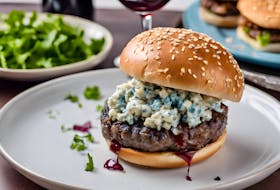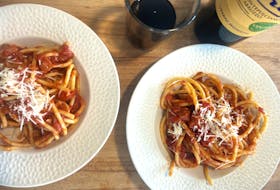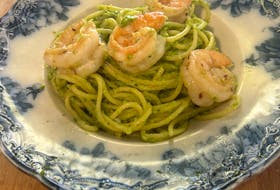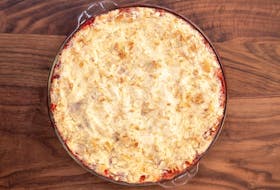Our cookbook of the week is My Korea: Traditional Flavors, Modern Recipes by Hooni Kim. Tomorrow, we’ll feature an interview with the author.
To try another recipe from the book, check out: Warm tofu with kimchi and pork belly stir-fry (dubu kimchi), and scallion pancakes (pajeon).
“It’s probably the most popular street food in Korea,” says Hooni Kim of tteokbokki. “Nobody doesn’t like rice cakes.”
Sold for roughly $5 at carts throughout South Korea, they’re typically stewed until meltingly soft. At Hanjan , one of Kim’s New York City restaurants, he takes a different approach — browning the rice cakes ever so slightly before coating them in a spicy red chili sauce.
“When I was cooking at Daniel , every composed dish had to have a contrasting colour, contrasting texture and contrasting flavour,” says Kim. “So with that in mind, for me, the best version of tteokbokki would give the rice cake itself two different textures. Soft and mushy inside, which is why Koreans love rice cakes in general, but crispy on the outside, which I thought Americans would appreciate more.”
HANJAN’S SPICY RICE CAKES
떡볶이 (Tteokbokki)
1 lb (455 g) precut frozen rice cakes, or 1 lb (455 g) fresh rice cakes, cut into 2- to 3-inch- (5- to 8-cm-) long batons
2 large eggs
1 tsp (5 mL) baking soda
1 tsp (5 mL) salt, plus more to taste
1 tbsp (15 mL) vinegar (any kind will do)
Sauce:
2 cups (500 mL) Dashi (recipe follows), plus more if needed
1/2 medium onion, minced
3 garlic cloves, minced
1 cup (250 mL) gochugaru (Korean red chili flakes)
2 tbsp (30 mL) sugar
1 tbsp (15 mL) gochujang (Korean red chili paste)
Salt if needed
1/2 cup (125 mL) grape seed or canola oil
1/2 lb (225 g) fish cakes, cut into batons the same size as the rice cakes
1 medium onion, thinly sliced
1/2 bunch scallions, cut into 1-inch (2.5-cm) batons
Step 1
If you are using frozen rice cakes, soak them in cold water for 1 hour after cutting. Fresh rice cakes can be used straight from the package.
Step 2
To prepare the soft-boiled eggs, add enough water to a small pot to cover the 2 eggs. Set over high heat, add the baking soda, salt and vinegar, and bring to a boil. (The baking soda makes it easier to peel the soft-boiled eggs and the vinegar will help centre the yolks.) Add the eggs and wait until the water starts to boil again, then lower the heat to maintain a gentle boil and cook for 6 minutes. While the eggs cook, prepare an ice bath. When they are cooked, immediately transfer the eggs to the ice bath. Chill for 5 minutes, or until they are cool enough to peel. Carefully peel the eggs. Slice lengthwise in half, sprinkle the yolks lightly with salt and set aside.
Step 3
To make the sauce, put the dashi in a medium pot set over high heat. Bring to a boil and boil to reduce the volume by half, 15 to 20 minutes. Add the onion, garlic, gochugaru, sugar and gochujang, reduce the heat to medium and cook for 15 to 20 minutes, until the onions are tender and the flavours have come together. Taste and add salt if necessary. Remove from the heat and reserve.
Step 4
Add the oil to a large skillet set over medium heat and when it just begins to smoke, add the rice cakes. Cook, turning the rice cakes occasionally, until they are crispy on all sides but have not browned much, 8 to 10 minutes; lower the heat if necessary. Add the fish cakes, onions and scallions, increase the heat to high and toss with a wooden spoon for about a minute or two, until everything is heated through. Add the sauce and stir for 2 or 3 minutes so the oil emulsifies with the sauce. The sauce should be thick enough to coat the rice cakes, but you may need to add a little more dashi or water if it reduces too much and starts to burn.
Serve the rice cakes family-style on a large plate, garnished with the soft-boiled eggs. Enjoy with cold glasses of makgeolli.
Serves: 4
DASHI
16 cups (4 L) cold water
One 6-inch (15-cm) square dashima
3 medium dried shiitake mushrooms
12 large dried anchovies (gutted and heads removed)
Step 1
Put the water, dashima, shiitake mushrooms and anchovies in a covered stockpot or other large pot and let stand at room temperature overnight, or for 8 to 12 hours.
Step 2
Remove the lid, set the pot over high heat and heat until the surface of the water begins to ripple; pay attention and do not let it come to a boil. Lower the heat to maintain a very gentle simmer (the ideal temperature is a few degrees below a light boil) and simmer for 80 to 90 minutes. Taste the dashi every 20 minutes to monitor the changes in flavour and texture. You will notice the texture becoming softer. I describe it as having a slippery, slightly viscous texture compared to tap water. The sea flavour will become stronger and the dashi will become darker, like pale Earl Grey tea. The sweetness will take a while to appear, but when it does, the dashi is almost ready. When you can taste the sweetness and deep sea flavours, and the dashi has a very soft texture, it is done. Be vigilant, because dashi will become bitter if cooked too long.
Step 3
Strain the dashi into a covered container and store in the refrigerator for up to 2 days. After 24 hours, the dashi will begin to lose some of its flavour and it will turn slightly flat.
Note: Vegetarians can make a dashi from just dashima and dried shiitakes.
Excerpted from My Korea: Traditional Flavors, Modern Recipes . Copyright (c) 2020 by Hooni Kim. Photographs copyright 2020 by Kristin Teig. Used with permission of the publisher, W. W. Norton & Company, Inc. All rights reserved.
Copyright Postmedia Network Inc., 2020








